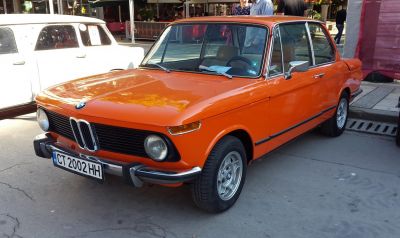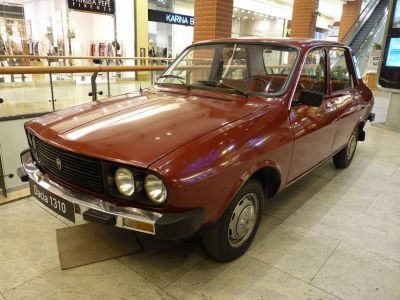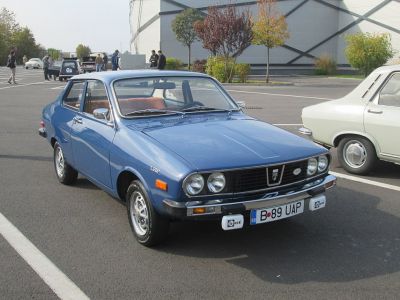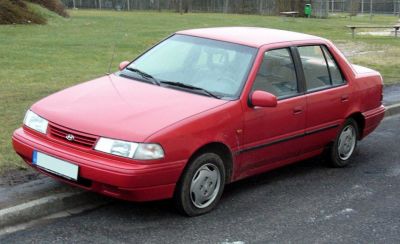 1969 Dacia 1300 Dimensions, Size & Specs
1969 Dacia 1300 Dimensions, Size & SpecsMeasurements of the 1969 Dacia 1300, engineered for optimal performance and comfort
| Dimensions | |
|---|---|
| Length: | 4345 mm171.1 in14.3 ft |
| Width: | 1635 mm64.4 in5.4 ft |
| Height: | 1435 mm56.5 in4.7 ft |
| Weight Specifications | |
| Curb Weight: | 890 kg1962 lbs |
| Tire Specifications | |
| Tire Size: |
|
The Dacia 1300 Sedan, produced from 1969 to 2004, is a hallmark of compact car design with a classic, functional silhouette. Measuring 4345 mm (171.1 inches) in length, 1635 mm (64.4 inches) in width, and 1435 mm (56.5 inches) in height, this vehicle comfortably fits within the compact sedan category, making it suitable for both urban and suburban use. It carries a curb weight of 890 kg (1,963 lbs), reflecting the lightweight and simplistic build typical of vehicles from its era, which contributed to its efficiency and ease of handling. Equipped with 155/80 R13 tires, the 1300 offers balanced road grip and ride comfort on various surfaces. The Dacia 1300 was widely appreciated for its affordability and robust engineering, making it a popular choice in Eastern Europe for several decades. This model’s dimensions place it competitively among other compact sedans of its time, offering adequate interior space while maintaining maneuverability. Whether viewed from a historical perspective or in terms of size classification, the Dacia 1300 remains a significant car model, symbolizing accessible transportation during the late 20th century.
Discover the standout features that make the 1969 Dacia 1300 a leader in its class
Have a question? Please check our knowledgebase first.
The Dacia 1300 from the 1969 generation measures 4345 mm (approximately 171.1 inches) in length, 1635 mm (about 64.4 inches) in width, and 1435 mm (around 56.5 inches) in height. These dimensions reflect a typical mid-sized sedan design of its era, providing a balanced footprint that suits both urban and rural environments. The relatively compact width and height allow for easier maneuverability and parking in tight spaces compared to modern cars, yet it still offers adequate interior space for passengers and cargo typical of a sedan.
The Dacia 1300 has a curb weight of approximately 890 kilograms (about 1962 pounds). This relatively low weight for a sedan contributes positively to its fuel efficiency and handling characteristics, especially considering its manufacturing period starting in 1969. The lighter weight places less strain on the engine and braking components, which enhances overall drivability and reduces fuel consumption compared to heavier vehicles. However, it also means the vehicle might offer less sound insulation and a somewhat less solid feel on the road compared to modern, heavier cars.
Yes, the Dacia 1300 fits well into a standard residential garage due to its dimensions. Typical garages have widths of around 2400-2700 mm (94.5-106 inches) and lengths of about 4800-5500 mm (189-216 inches), which comfortably accommodate the Dacia 1300's 1635 mm (64.4 in) width and 4345 mm (171.1 in) length. Owners should, however, consider leaving sufficient clearance around the vehicle for easy ingress and egress, as well as room for any storage or activities planned inside the garage.
Compared to other sedans from the late 1960s through the early 2000s, the Dacia 1300's dimensions of 4345 mm length, 1635 mm width, and 1435 mm height place it in a slightly compact to mid-sized category. While some competitors might have been larger in length and width, the Dacia 1300 was designed to meet the needs of practical urban and rural use with an emphasis on affordability and reliability. Its size made it less cumbersome in narrow city streets and easier to maintain than bulkier models, reflecting automotive trends seen in Eastern Europe and developing markets during that time.
The Dacia 1300 is equipped with tires sized 155/80 R13. This means the tire width is 155 mm, the sidewall height is 80% of the width, and it fits 13-inch diameter wheels. These relatively narrow tires contribute to a ride that emphasizes comfort and fuel economy over sporty handling. The taller sidewalls provide good absorption of bumps and road imperfections, which suits the typical road conditions where the vehicle was popular. However, narrower tires have less grip compared to wider contemporary tires, which influences the vehicle’s handling and braking performance.
Despite its modest exterior dimensions, the Dacia 1300 was designed to maximize interior space for passengers. With a length of 4345 mm and width of 1635 mm, the sedan layout allows seating for five occupants with reasonable legroom and headroom for its class during the production era. The height of 1435 mm balances a relatively low profile with adequate head clearance inside. The design focuses on practicality rather than luxury, so while the seating is comfortable for short to medium journeys, features such as cushioning and cabin noise insulation are more minimal compared to modern vehicles.
The Dacia 1300 was essentially based on the Renault 12 platform and replaced earlier Dacia models with more outdated designs. Compared to predecessors like the Dacia 1100, the 1300 featured increased dimensions—particularly in length and width—offering more interior space and modern styling cues. This generation introduced a more aerodynamic shape, improved mechanical components, and better overall build quality. These enhancements reflected a shift toward modernity and user comfort, marking a significant step up from the older, smaller, and less efficient models produced before 1969.
The Dacia 1300 shares many similarities with the Renault 12, as it was essentially a licensed version produced locally. Both cars have very similar exterior dimensions, with the Dacia 1300 measuring 4345 mm in length and 1635 mm in width, closely matching the Renault 12's footprint. In comparison to contemporaneous Škoda sedans, the Dacia 1300 is generally a bit more modern and spacious, particularly in interior layout and mechanical refinement. However, while the Renault 12 might benefit from more advanced features and engineering, the Dacia aimed to offer a more affordable and robust alternative suited for the Eastern European market.
The Dacia 1300 holds a special place among classic car enthusiasts, especially in Eastern Europe where it symbolizes accessible personal mobility from the late 20th century. Its modest dimensions make it manageable to park and drive in today’s traffic. While it doesn’t offer the luxury or performance of some Western classics, its authenticity, simplicity, and the nostalgia attached to its widespread use over three decades grant it considerable collector appeal. The Dacia 1300 is appreciated for its historical value, ease of repair, and the familiarity it evokes for many owners and fans.
From a modern perspective, the Dacia 1300's compact dimensions (4345 mm length, 1635 mm width), low curb weight (890 kg), and simple design make it a practical vehicle for urban driving, narrow roads, and easy parking. However, its aged mechanical and safety features mean it is less suitable for freeway speeds or long-distance travel compared to contemporary cars. Its smaller tires and basic suspension are optimized for slower speeds and less demanding road conditions. For daily use, it's better suited as a nostalgic or hobby vehicle rather than a primary transportation mode in today's complex traffic and regulatory landscapes.
Discover similar sized cars.

| Production: | 1967-1977 |
|---|---|
| Model Year: | 1966 |
| Length: | 4220-4320 mm166.1-170.1 in |
| Width: | 1590-1620 mm62.6-63.8 in |
| Height: | 1410 mm55.5 in |

| Model Year: | 1984 |
|---|---|
| Length: | 4340-4390 mm170.9-172.8 in |
| Width: | 1615-1660 mm63.6-65.4 in |
| Height: | 1430-1440 mm56.3-56.7 in |

| Model Year: | 1985 |
|---|---|
| Length: | 4340 mm170.9 in |
| Width: | 1636 mm64.4 in |
| Height: | 1430 mm56.3 in |

| Model Year: | 1989 |
|---|---|
| Length: | 4275 mm168.3 in |
| Width: | 1605 mm63.2 in |
| Height: | 1385 mm54.5 in |

| Production: | 2013-2016 |
|---|---|
| Model Year: | 2013 |
| Length: | 4410 mm173.6 in |
| Width: | 1700 mm66.9 in |
| Height: | 1475 mm58.1 in |
